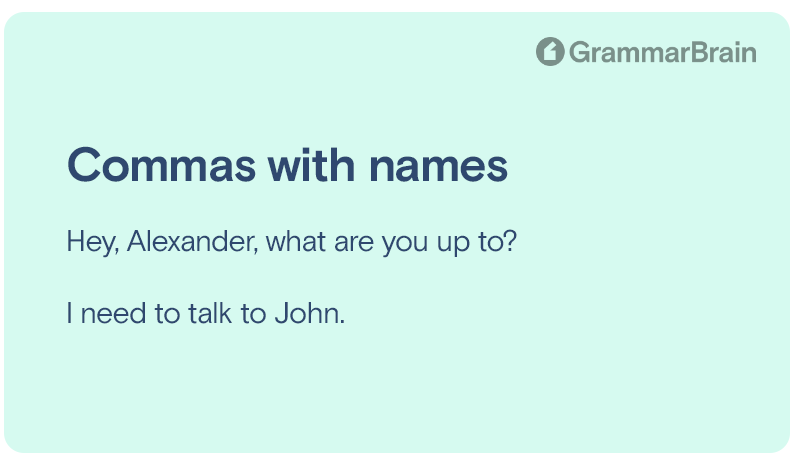Do commas come after names? It’s a well-established fact that the usage of commas is far more potent than its basic appearance suggests. It can drastically change the basic appearance and meaning of any particular sentence. One example is “Harry will work, he will get never paid in the job Harry will be underpaid.”
This proverb answers the question where one is confused about whether Harry should take up a relevant job or not.
When a comma is used before “never,” the answer changes to a green light, whereas using it before “never changes the response to a warning form.
In this blog, we will look at various types of commas, their examples and how to use commas after names, and the importance it holds

Do commas come after names? What is a Vocative Comma?
A vocative comma is employed to signify a personal address within the framework of a sentence. The vocative case is used when addressing another individual directly.
This vocative case needs to be separated from the rest of the sentence by the vocative comma, which separates it from phrases and sentences that stand on their own. It’s a great way to show who you’re talking to without altering the sense of the sentence.
In Latin, the word vocative shares its origin with the word vocation, which means “a calling,” where the vocative case first appeared.
So, when you want to address a person specifically, you take the help of vocative commas. The phrase “Tell me, Bob, what you plan to do about this” illustrates this phrase.
There is no doubt that we are talking to Bob here because of the vocative commas surrounding the name.
| Form | Definition |
| Vocative comma | A vocative comma is a punctuation mark used to indicate a direct address in the context of a larger sentence. |
What are oxford commas? (examples
Oxford Comma is a comma before a list’s last conjunction. The Oxford comma goes before “and” in “the flag was red, white, and blue.”
Oxford comma proponents say it eliminates sentence similarities. Opponents consider the Oxford comma as unnecessary and oppose its use.
Some examples of oxford commas are:
- “Larry likes chicken, pizzas, and pasta”
If we write without oxford commas, it would be a completely different statement:
- “Larry likes Chicken pizzas and pasta. Here it means that Larry is fond of Chicken Pizzas, not Chicken, Pizzas separately.”
Do you use commas after addressing someone in an email?
There is a set of rules for using commas in a business email. A comma can be used after addressing someone, after which the subject line comes.
But confusion arises when we write Dear or Hello. When should we use commas in a business email, whether before a name or after?
Here are some examples with explanations:
When we use Dear in our business email, we put commas after the name of the person we are addressing. In case of a simple ‘Hi’ or’ Hello,’ We use commas after Hi and before the addressee’s name.
Dear Larry,
Hi, Sharon,
We are too grateful for your invitation.
What are examples of using commas after names?
There are various examples of using commas after names, either in direct or indirect quotations. It all depends on the situation.
In direct quotations:
- “I dislike concerts,” proclaimed Mary, “because the music is too loud.”
- “She likes food,” joked Harry,”because she is a foodie”
In direct address:
- “The mystery of the happiness has to be solved by Mariah’s sister, Elizabeth.”
- “My friend Anita, who won a scholarship, is leaving tomorrow.”
- “I think, John, you are wrong.”
Are commas essential in writing?
As a lighthearted way to wrap out this examination of the comma, here’s a scenario that exemplifies the need for fluency with this common but frequently misunderstood element of written communication.
This example is based on one provided by Lynne Truss in her punctuation guide Eats, Shoots, and Leaves, with some minor changes.
Here’s a sentence to think about:
- “Having a man in her life is what makes her whole.”
That’s not the best thing to say. (Whenever I read this statement aloud in class, I get a lot of angry looks from the girls).
Let’s add some commas to this statement to make it better:
- A woman: what a man would be lacking without her.
Just by adding two commas, the entire meaning of this statement has been transformed. The meaning conveyed by the second statement is diametrically opposed to that of the first.
The use of commas is crucial. All too frequently, commas are viewed as decorative, needless separators between words. This sentence, which only needed two commas to be perfect, exemplifies the power of the comma.
Although commas don’t always cause a dramatic shift in meaning like the one demonstrated above, they often do. Even though they don’t change the complete meaning of a particular sentence, commas might help a reader understand how to read that text.
Using commas reminds the reader to pause for breath and tone down his or her voice at the appropriate times. In the case of larger sentences, commas are used to separate phrases, clauses, and different words.
It is possible to compare the role commas play in writing to that of musical rests or the visual equivalent, negative space. Writers who master the comma have mastered the ability to control absence and presence.
Inside this article
Fact checked:
Content is rigorously reviewed by a team of qualified and experienced fact checkers. Fact checkers review articles for factual accuracy, relevance, and timeliness. Learn more.
Core lessons
Glossary
- Abstract Noun
- Accusative Case
- Anecdote
- Antonym
- Active Sentence
- Adverb
- Adjective
- Allegory
- Alliteration
- Adjective Clause
- Adjective Phrase
- Ampersand
- Anastrophe
- Adverbial Clause
- Appositive Phrase
- Clause
- Compound Adjective
- Complex Sentence
- Compound Words
- Compound Predicate
- Common Noun
- Comparative Adjective
- Comparative and Superlative
- Compound Noun
- Compound Subject
- Compound Sentence
- Copular Verb
- Collective Noun
- Colloquialism
- Conciseness
- Consonance
- Conditional
- Concrete Noun
- Conjunction
- Conjugation
- Conditional Sentence
- Comma Splice
- Correlative Conjunction
- Coordinating Conjunction
- Coordinate Adjective
- Cumulative Adjective
- Dative Case
- Determiner
- Declarative Sentence
- Declarative Statement
- Direct Object Pronoun
- Direct Object
- Diction
- Diphthong
- Dangling Modifier
- Demonstrative Pronoun
- Demonstrative Adjective
- Direct Characterization
- Definite Article
- Doublespeak
- False Dilemma Fallacy
- Future Perfect Progressive
- Future Simple
- Future Perfect Continuous
- Future Perfect
- First Conditional
- Irregular Adjective
- Irregular Verb
- Imperative Sentence
- Indefinite Article
- Intransitive Verb
- Introductory Phrase
- Indefinite Pronoun
- Indirect Characterization
- Interrogative Sentence
- Intensive Pronoun
- Inanimate Object
- Indefinite Tense
- Infinitive Phrase
- Interjection
- Intensifier
- Infinitive
- Indicative Mood
- Participle
- Parallelism
- Prepositional Phrase
- Past Simple Tense
- Past Continuous Tense
- Past Perfect Tense
- Past Progressive Tense
- Present Simple Tense
- Present Perfect Tense
- Personal Pronoun
- Personification
- Persuasive Writing
- Parallel Structure
- Phrasal Verb
- Predicate Adjective
- Predicate Nominative
- Phonetic Language
- Plural Noun
- Punctuation
- Punctuation Marks
- Preposition
- Preposition of Place
- Parts of Speech
- Possessive Adjective
- Possessive Determiner
- Possessive Case
- Possessive Noun
- Proper Adjective
- Proper Noun
- Present Participle
- Prefix
- Predicate



